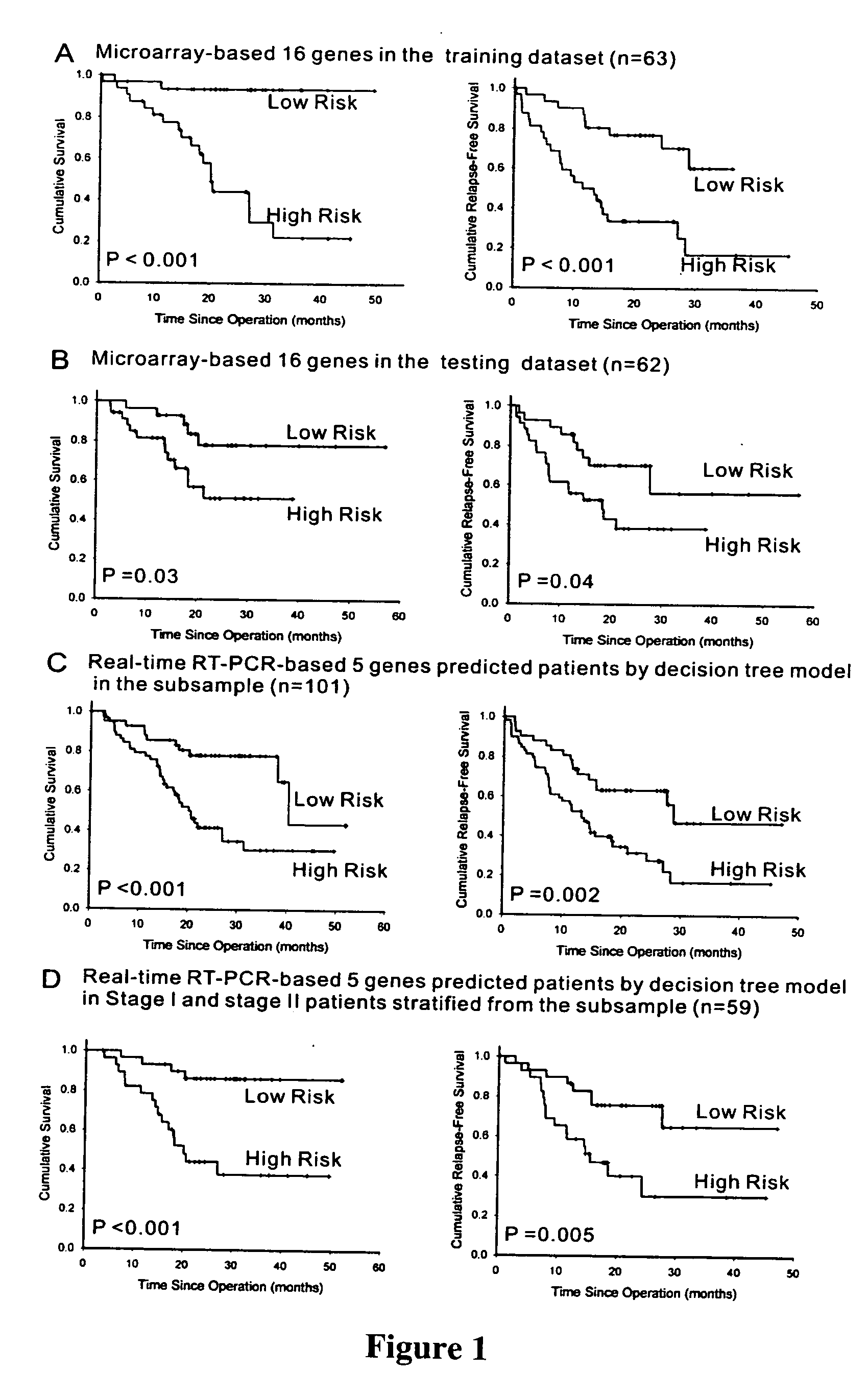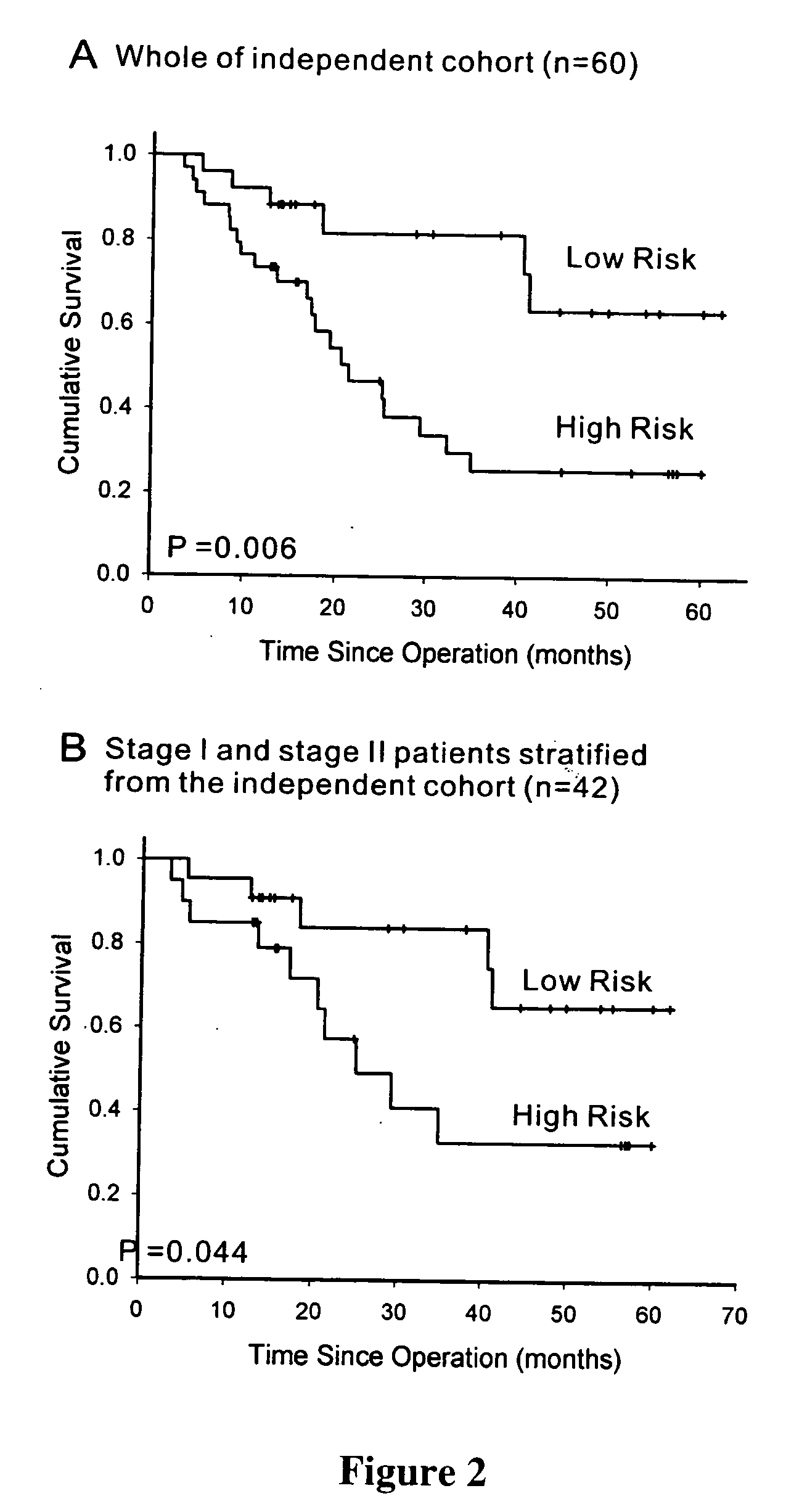Metastasis-associated gene profiling for identification of tumor tissue, subtyping, and prediction of prognosis of patients
a metastatic gene and gene profiling technology, applied in the field of metastatic gene profiling for the identification of tumor tissue, subtyping, and prediction of the prognosis of patients, can solve the problems of increasing the risk of lung biopsy and surgery, reducing the effectiveness of early detection efforts, and reducing mortality
- Summary
- Abstract
- Description
- Claims
- Application Information
AI Technical Summary
Benefits of technology
Problems solved by technology
Method used
Image
Examples
example 1
Genes for Identification of Tumor Tissue
[0071] Microarray raw data was processed as described in the Data Pretreatment of the previous section. The logarithmic intensity was further normalized using the PROC RANK of the statistical software SAS (version 9.1; SAS Institute Inc., Cary, N.C., USA).
[0072] Microarray data obtained from tumor tissue and its adjacent normal tissue in each individual was then treated as paired data for statistical analysis. A Wilcoxon signed-rank test was used to select those genes with significant differences in expression level between the paired tissue as described in the Avadis™ user manual (Avadis™ user manual. (2004) USA, Strand Genomic Pvt Ltd.; and Rosner R. (2000) Fundamentals of biostatistics (ed 5). California, USA, Duxbury). A false discovery rate (FDR) was applied to calculate the corrected p values, in order to control the false positive rate at a nominal level of 0.05 (Benjamini and Hochberg, (1995) J. the Royal Sta...
example 2
Genes for Subclassification of Lung Carcinomas
[0078] We further examined whether gene expression profile can be applied for distinguish different subtypes of lung carcinomas, especially two major types, adenocarcinomas and squamous cell carcinomas.
[0079] Microarray raw data were processed as described in Data Pretreatment of the previous section. The logarithmic intensity was further normalized using the PROC RANK of the statistical software SAS (version 9.1; SAS Institute Inc., Cary, N.C., USA).
[0080] Only the intensity data obtained from tumor tissue specimens was randomly grouped into training dataset and testing dataset before the statistical analysis (Table 3 (B)). Wilcoxon rank-sum test, a non-parametric method for independent samples was processed, while 10,000 times of permutation was employed for gene selection (Rosner R. Fundamentals of biostatistics (ed 5). (2000) California, USA, Duxbury; Draghici S. Data analysis tools for DNA microarrays. (2...
example 3
Gene Expression Signatures to Predict Metastasis and Survival of Non-Small Cell Lung Cancer
[0084] Microarray raw data was processed as described in Data Pretreatment of the previous section. Only the intensity data obtained from tumor tissue specimens were randomly grouped into training dataset and testing dataset before the statistical analysis.
[0085] For the prediction of prognosis, the intensity of gene expression was coded as an ordinal level from 1 to 4, depending on the percentile of its intensity distributed in the range from the first (0-25%) the second (25%-50%), the third (50%-75%), or the fourth (75%-100%) range, respectively.
2. Selection of Survival-Associated Genes
[0086] Univariate Cox's proportional hazards regression analysis (Cox D R. Regression Models and Life-Tables. Journal of the Royal Statistical Society Series B (1972) 34:187-220) of individual gene was applied to selection of overall survival-associated genes. A Cox's regression c...
PUM
| Property | Measurement | Unit |
|---|---|---|
| Gene expression profile | aaaaa | aaaaa |
| Level | aaaaa | aaaaa |
Abstract
Description
Claims
Application Information
 Login to View More
Login to View More - R&D
- Intellectual Property
- Life Sciences
- Materials
- Tech Scout
- Unparalleled Data Quality
- Higher Quality Content
- 60% Fewer Hallucinations
Browse by: Latest US Patents, China's latest patents, Technical Efficacy Thesaurus, Application Domain, Technology Topic, Popular Technical Reports.
© 2025 PatSnap. All rights reserved.Legal|Privacy policy|Modern Slavery Act Transparency Statement|Sitemap|About US| Contact US: help@patsnap.com



